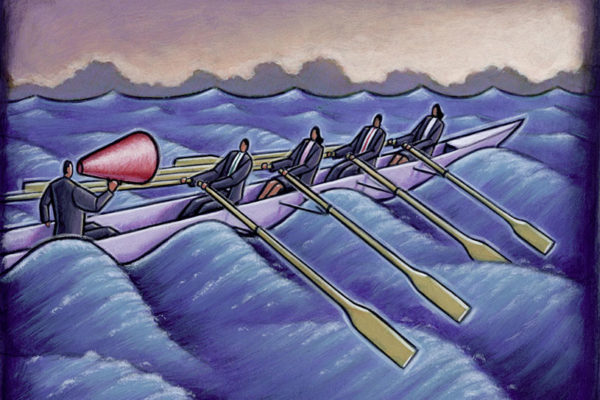How winning teams navigate conflict to stay on course

Award-winning research by Beta Mannix and colleagues details strategies successful teams used to manage conflict.
When people work together as a team, some disagreement and personality clashes are inevitable. But why do some teams become derailed by conflict, while others manage to work through conflicts to deliver great performance?
That question was the basis of a 2008 landmark study coauthored by Johnson Professor of Management and Organizations Beta Mannix; William M. K. Trochim of Cornell’s College of Human Ecology; Kristin J. Behfar of the University of Virginia’s Darden School of Business; and Randall S. Peterson of London Business School. Their paper, “The critical role of conflict resolution in teams: A close look at the links between conflict type, conflict management strategies, and team outcomes,” received the Most Influential Paper award for 2016 from the Conflict Management division of the Academy of Management, an honor recognizing a paper that has “made a significant and influential contribution” to conflict management research over the years.
“This paper has become foundational in a number of ways,” says Mannix. “People are using it to contribute to their own work, not only empirically, but theoretically as well.” The research has also provided organizations with insight into how teams work and strategies for intervening in poorly performing teams.
Both the researchers’ findings and their method were groundbreaking, shaping subsequent researchers’ perceptions and study of conflict. Mannix and her coauthors uncovered distinct connections among a team’s conflict management strategies, performance, and members’ satisfaction. Their multifaceted approach incorporated quantitative and qualitative data and studied teams’ interactions over several months “to understand how conflict unfolded from the very beginning — the formation of new, randomly formed teams — to the very endpoint,” she explains. Previous research looked only at “snapshots” of teams, via single-shot surveys, for example.
Conducted in the fall of 2007, the study gauged the performance and interaction among Johnson’s first-year, residential MBA class of 252 students, who formed self-managing teams to work through the core curriculum. The researchers studied the students throughout their first semester, administering survey questionnaires at two different times to gauge their levels of conflict and satisfaction.
Performance was measured by the teams’ grades in several courses. Survey responses, which included both open-ended responses and Likert-style numerical-satisfaction ratings, were analyzed by experts to measure three discrete types of conflict: task conflict (disagreement about what to focus on), relationship conflict (personal clashes), and process conflict (dissent over how to achieve the goal).
Previous researchers had considered task conflict to be always positive (engendering critical thinking and creative solutions), and relationship conflict to be negative (creating bad will and tension). They were unclear about process conflict, which can overlap with task conflict.
Measuring both performance and satisfaction, Mannix and her colleagues found that how teams dealt with conflict was most critical to team success, not the type of conflict. The researchers found that the teams with the best overall result — high performance and high satisfaction — were proactive about determining ways to productively resolve conflicts, assigned roles according to expertise, understood clearly how each member’s interests aligned with team goals, and based decisions on evidence and analysis rather than bowing to personality clashes.
Some teams experienced high satisfaction but low performance. This occurred in a few different ways – most often, among teams attempting to build harmony by including every member’s contributions at the expense of the team mission. “In other cases, there is a struggle for who is ‘right,’ and the end result is taking everyone’s ideas into account,” says Mannix. “It’s easy to fall into: You decide to focus on personal satisfaction and harmonious relationships, and let go of the actual task you are supposed to focus on.”
Other teams had lower satisfaction, but turned in good performance, often because they set clear expectations and imposed clear rules when they experienced relationship conflicts. “It’s not unusual that a team becomes dysfunctional, that you have one or more people who don’t get along well,” says Mannix. “But it can be possible to work with together if you put in a structure to help solve some of the problems that are focused on the task itself, not trying to change someone’s personality.”
Finally, “avoidant or miserable” teams had low performance and low satisfaction. Members often avoided meetings as well as each other, put decisions to a vote rather than discussing them, and relied on trial and error to define their procedures.
A derailed team may correct its course by putting rules and structure into place “to get members away from conflict over unnecessary and reactive kinds of problems,” says Mannix. “The best way I’ve seen teams get back on track is to have an outside facilitator or coach come in to stop and reassess where we are and why we are here, and spend time with the team. That could mean getting people to come to meetings on time, assigning specific roles, implementing a team contract, or enforcing an existing team contract.”
Mannix sees the paper’s influence on current research evident in researchers’ focus on process conflict and how it affects teams’ performance, and in more studies looking longitudinally at conflict and team performance over time.
Moreover, organizations are using the findings to improve their teams. “I’ve had people come back and report to me, ‘This works! We weren’t managing the task itself; we were too focused on the relationships,’” says Mannix. “It’s a bit of an ‘Aha!’ and it gives them tools to think through their interactions more effectively.”
Related Link:
Clash of the Teammates: How the Ideal Team Works Through Conflict by Kristin J. Behfar, associate professor of business administration, Darden School of Business, University of Virginia
Illustration credit: Garry Nichols /Illustration Source
Beta Mannix, associate dean for Executive MBA programs

Beta Mannix is Johnson’s associate dean for Executive MBA programs, Ann Whitney Olin Professor of Management, and professor of management and organizations. Her research and teaching interests include influence, power and executive presence, diversity and women in leadership, strategic negotiation, high performance teams, and organizational change and renewal. Widely published in many peer-reviewed journals, she is also the co-editor of the 15 volume book series, Research on Managing Groups and Teams. Her work has been recognized by awards from several organizations, including the Academy of Management, Small Group Research, and the International Association for Conflict Management. She is a Fellow of the American Psychological Society, the Society for Organizational Behavior, and The Academy of Management.

Comments